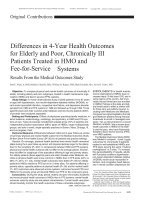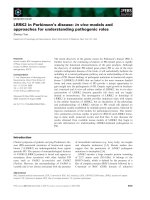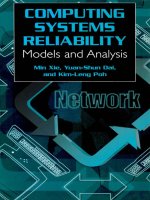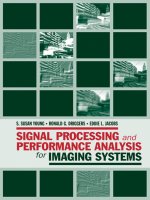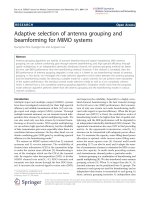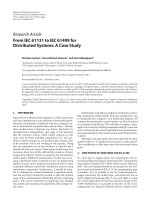models and analysis for distributed systems
Bạn đang xem bản rút gọn của tài liệu. Xem và tải ngay bản đầy đủ của tài liệu tại đây (4.09 MB, 346 trang )
Models and Analysis in Distributed Systems
www.it-ebooks.info
Models and Analysis in
Distributed Systems
Edited by
Serge Haddad
Fabrice Kordon
Laurent Pautet
Laure Petrucci
www.it-ebooks.info
First published 2011 in Great Britain and the United States by ISTE Ltd and John Wiley & Sons, Inc.
Apart from any fair dealing for the purposes of research or private study, or criticism or review, as
permitted under the Copyright, Designs and Patents Act 1988, this publication may only be reproduced,
stored or transmitted, in any form or by any means, with the prior permission in writing of the publishers,
or in the case of reprographic reproduction in accordance with the terms and licenses issued by the
CLA. Enquiries concerning reproduction outside these terms should be sent to the publishers at the
undermentioned address:
ISTE Ltd John Wiley & Sons, Inc.
27-37 St George’s Road 111 River Street
London SW19 4EU Hoboken, NJ 07030
UK USA
www.iste.co.uk www.wiley.com
© ISTE Ltd 2011
The rights of Serge Haddad, Fabrice Kordon, Laurent Pautet and Laure Petrucci to be identified as the
authors of this work have been asserted by them in accordance with the Copyright, Designs and Patents
Act 1988.
___________________________________________________________________________
Library of Congress Cataloging-in-Publication Data
Models and analysis in distributed systems / edited by Serge Haddad [et al.].
p. cm.
Includes bibliographical references and index.
ISBN 978-1-84821-314-2
1. Distributed parameter systems Simulation methods. 2. System analysis. I. Haddad, Serge.
T57.62.M63 2011
003.78 dc23
2011012244
British Library Cataloguing-in-Publication Data
A CIP record for this book is available from the British Library
ISBN 978-1-84821-314-2
Printed and bound in Great Britain by CPI Antony Rowe, Chippenham and Eastbourne.
www.it-ebooks.info
Contents
Foreword
Chapter 1. Introduction 17
Serge H
ADDAD, Fabrice KORDON,LaurentPAUTET and Laure PETRUCCI
FIRST PART.FORMAL MODELS FOR DISTRIBUTED SYSTEMS 21
Chapter 2. Introduction to Formal Models 23
Laure P
ETRUCCI
2.1.Motivation 23
2.2.Semi-formalmodels 24
2.3.Formalmodels 27
2.4.Afterspecification,verification 35
2.5. Outline of Part I . . . . . . . . . . . . . . . . . . . . . . . . . . . . . . . . 37
2.6.Bibliography 37
Chapter 3. Specification and Design Approaches 41
Christine C
HOPPY and Laure PETRUCCI
3.1. Introduction . . . . . . . . . . . . . . . . . . . . . . . . . . . . . . . . . . 41
3.2.Criteriafordevelopingspecifications 42
3.3. Specification development methodologies . . . . . . . . . . . . . . . . . 50
3.4.Conclusion 60
3.5.Bibliography 60
Chapter 4. Modeling Time 63
Béatrice B
ÉRARD
4.1. Introduction . . . . . . . . . . . . . . . . . . . . . . . . . . . . . . . . . . 63
4.2.Semanticsoftimedmodels 65
v
9
Claude G
IRAULT
www.it-ebooks.info
4.3.Classicaltimedmodels 68
4.4.Specificationoftimingrequirements 85
4.5.Conclusion 90
4.6.Bibliography 90
Chapter 5. Architecture Description Languages 97
Pascal P
OIZAT and Thomas VERGNAUD
5.1. Introduction . . . . . . . . . . . . . . . . . . . . . . . . . . . . . . . . . . 97
5.2.Concepts 100
5.3.FormalADLs 109
5.4.ADLsforactualimplementation 117
5.5.Conclusion 130
5.6.Bibliography 130
S
ECOND PART.VERIFICATION TECHNIQUES FOR DISTRIBUTED SYS-
TEMS 135
Chapter 6. Introduction to Verification 137
Serge HADDAD
6.1. Introduction . . . . . . . . . . . . . . . . . . . . . . . . . . . . . . . . . . 137
6.2.Formalmodelsforverification 138
6.3.Expressionofproperties 141
6.4. Verification methods . . . . . . . . . . . . . . . . . . . . . . . . . . . . . 144
6.5. Outline of Part 2 . . . . . . . . . . . . . . . . . . . . . . . . . . . . . . . 151
6.6.Bibliography 151
Chapter 7. Verification of Finite-State Systems 155
Jean-François P
RADAT-PEYRE and Yann THIERRY-MIEG
7.1. Introduction . . . . . . . . . . . . . . . . . . . . . . . . . . . . . . . . . . 155
7.2. Petri net definition . . . . . . . . . . . . . . . . . . . . . . . . . . . . . . 156
7.3.Structuralapproaches 158
7.4.Formalverificationbymodel-checking 183
7.5.Classificationofmodel-checkingapproaches 191
7.6.Decisiondiagram-basedapproaches 194
7.7.Partialorderreductions 203
7.8. Reductions exploiting symmetry . . . . . . . . . . . . . . . . . . . . . . 212
7.9.Conclusion 214
7.10.Bibliography 215
Chapter 8. Verification of Infinite-State Systems 221
Stéphane D
EMRI and Denis POITRENAUD
8.1. Introduction . . . . . . . . . . . . . . . . . . . . . . . . . . . . . . . . . . 221
6 Models and Analysis in Distributed Systems
www.it-ebooks.info
Contents 7
8.2. Counter systems . . . . . . . . . . . . . . . . . . . . . . . . . . . . . . . 225
8.3.RecursivePetrinets 233
8.4. Presburger arithmetic as symbolic representation . . . . . . . . . . . . . 250
8.5.Concludingremarks 263
8.6.Bibliography 263
Chapter 9. Verification of Timed Systems 271
Pierre-Alain R
EYNIER
9.1. Introduction . . . . . . . . . . . . . . . . . . . . . . . . . . . . . . . . . . 271
9.2.Constructionoftheregiongraph 273
9.3.Handlinginfiniteabstractions 284
9.4.Robustnessissuesintimedsystems 293
9.5.Conclusion 303
9.6.Bibliography 303
Chapter 10. Distributed Control 307
Claude D
UTHEILLET, Isabelle MOUNIER and Nathalie SZNAJDER
10.1. Introduction . . . . . . . . . . . . . . . . . . . . . . . . . . . . . . . . . 307
10.2. Decentralized Control . . . . . . . . . . . . . . . . . . . . . . . . . . . 311
10.3. Controller synthesis for distributed systems . . . . . . . . . . . . . . . 323
10.4. Multi-player games . . . . . . . . . . . . . . . . . . . . . . . . . . . . . 339
10.5.Conclusion 346
10.6.Bibliography 346
Index 35
353List of Authors
5
www.it-ebooks.info
Foreword
Verification and hence modeling are a mandatory but intricate problem for engi-
neers developing embedded distributed real-time systems that are entrusted with criti-
cal safety applications like medical care, transportation, energy production, industrial
processes, military operations. Therefore, while emerging 40 years ago, first for cir-
cuit design, avionics and finally for all domains, verification environments are now
widely exploited by industry and fully integrated into the development processes.
Volume 1 presented design and algorithms for developing these large-scale dis-
tributed systems, real-time embedded ones, security concepts for peer-to-peer and
ubiquitous computing. However the crucial problem of their correctness is made
hard by their complexity, the difficulty of managing fault tolerance, the real-time con-
straints that they must satisfy, asynchronism of worldly spread units as well as the
heterogeneity of devices, networks and applications.
This second volume presents different approaches for mastering these verification
problems, beginning with the main concepts and formal methods used for modeling
and well structuring distributed systems and for expressing their logical and timed
properties. Then it explores the theoretical approaches, mainly logic and automata
theory, for behavioral verification of these models. It goes thoroughly into the decid-
ability issues and algorithmic complexity that are the inherent obstacles to overcome
particularly for dealing with infinite state spaces and timed models. Collecting the ex-
perience of researchers from several laboratories, this volume covers advanced topics
of distributed system modeling and verification. It aims at giving a deep knowledge of
theory, methods and algorithms to Masters and PhD students as well as to engineers
who are already good experts in verification.
Semi-formal specifications and models are a first step for a precise system de-
scription. The Unified Modeling Language (UML), widely used in industry, provides
diagrams for describing the relations between classes, objects, operations, activities,
and allows for examining the system action sequences, reachable states and desired
ix
www.it-ebooks.info
properties. Such specifications provide a good understanding of the system and al-
low early detection of some errors. Furthermore, formal models, such as algebraic
specification, automata, Petri nets (PN), process algebras, bring abstraction, precision
and rigor byprecisely describing all the possible behaviors of a system. They allow
for performing exhaustive simulation and therefore checking some safety and liveness
properties. Moreover temporal logics like Linear Time Logic (LTL) and Computation
Tree Logic (CTL) are introduced to express properties of sequences of states gener-
ated by these formal models. However the size of the generated sets of states may be
so huge that it raises the problems of complexity of the space and time needed to build
and explore them. These sets may even be infinite and their manipulation requires
sophisticated methods.
Whatever the chosen formalism, system modeling has to keep verification in mind.
The abstraction level needs to identify the system elements that must be taken into
account, while neglecting those which are out of the verification purposes. Once iden-
tified, the system relevant elements are progressively taken into account, and refined.
Incremental construction allows us to validate successive refinements. Model oriented
engineering approaches may be based on problem frames, architectural or component
architectures. Property oriented approaches may use languages like the Common Al-
gebraic Specification Language (CASL) extended with a Labelled Transition Logic to
express conditions satisfied by states, requirements on the transitions and incompatible
elementary actions.
As modern distributed systems and consequently their models become very large
and complex it is important to express their structure. Architecture and Analysis De-
scription Languages (AADL) help to manage and improve it by component compo-
sition via interfaces and packages, providing a convenient analysis support in case of
future reconfigurations or evolutions.
System verification depends heavily upon the interrelated choices concerning the
expressiveness of the formal model, the system requirements and expected properties,
the adequate verification methods and moreover the quality of the available tools. Ax-
iomatic proof of properties is highly desirable, but even if computer-aided it needs
intensive work for system formalization (much more difficult than modeling) and rig-
orous checking by highly trained engineers. Moreover, repetitions for each design
correction increase cost and delay. Therefore engineers mainly use automatic verifi-
cation based on numerous model checking methods. Researches combine the advan-
tages and drawbacks of methods, extend the models and develop new strategies. Many
subtle variants of models and classes of properties may drastically change complex-
ity in time or in space, or require ingenious extensions of methods and algorithms at
the decidability borders. Often expressiveness is costly for analysis. Inhibitor or re-
set arcs of PN make reachability undecidable. Decidability of counter automata may
be obtained by restricting their counters and avoiding zero tests. Association of time
with tokens instead of transitions requires more complex constructions for reachability
10 Models and Analysis for Distributed Systems
Models and Analysis in Distributed Systems
www.it-ebooks.info
Foreword 11
proofs. Fortunately some powerful extensions have been defined without theoretical
loss. Colored PN still allow positive linear flows and easily understandable invariants,
symmetries and parameterization. Recursivity is smartly introduced for PN keeping
their most useful properties. Colored semantics of PN by unfolding although rather
cumbersome, allows for efficient verification and reductions. PN box calculus allows
CCS-like process algebra but nevertheless decidability of verification.
Expression of properties is the most sensitive choice. Generic ones like bounded-
ness, liveness, even home states are useful but not sufficient for verifying the complex
behavior of distributed systems. Therefore temporal logics expressing the intricate
succession of events are so essential that for the past 40 years much research has fo-
cussed on them, thus leading to effective automatic verification of complex systems.
For this reason, the pioneer fundamental work of E. Clarke, A. Emerson and J. Sifakis
has been recognized by the 2007 ACM Turing Award.
The state graph is the key object for verification. Even when finite, it may be
exponentially huge w.r.t. the model size so that its reduction is a major goal. Some
model simplifications, like agglomerations of actions, allow us to suppress many in-
termediate states and meaningless interleaving effects, provided suitable conditions
preserve behavioral properties. For Petri nets, intricate behavioral conditions on fir-
ing sequences provide powerful agglomerations but the help of structural properties
simplifies their checking. Avoiding the state graph, structural verifications of PN use
flows, invariants, systems of integer linear inequalities and distinguished place sub-
sets. For better behavioral verification, a system is abstracted as an automaton accept-
ing transition sequences of infinite length. To be checked, a Linear-time Temporal
Logic formula Φ is automatically translated into a second automaton, called a Büchi
automaton, whose language is the sets of words that contradict Φ. Their “synchro-
nized product” is built to check if they have no common word (emptiness test) and Φ
holds, otherwise a counter example is found.
The memory space for these automata may be reduced by representing only the
index states in a hash table, or by neglecting parts of the state space irrelevant for
checking a particular formula. Better still, the widely used Binary Decision Diagrams
(BDD) provide an extremely compact representation of a state space as a Directed
Acyclic Graph of Boolean functions sharing most of their common subexpressions.
BDD may grow linearly even when state graphs grow exponentially. They are also
extended to represent whole graphs and automata allowing us to check paths and to
achieve model checking for CTL as well as for LTL. Variants again provide more
compactness (Zero suppressed BDD) or larger scopes (Algebraic DD, Multi-valued
DD and Data DD). Interleaving partial executions of actions is a major cause of space
explosion; therefore important gains are obtained by using equivalence classes of in-
dependent action subsequences. Covering Step Graphs, partial order methods and
trace unfoldings lead to many improvements like persistent sets, sleep sets, stubborn
sets. Distributed systems often have identical components, modeled by Colored Petri
www.it-ebooks.info
Nets (CPN) so their behavioral symmetries allow us to use quotient state graphs and
compact symbolic representations. All these improvements now help model checking
of large distributed systems, mainly hardware and embedded ones.
Verification of infinite state systems is a challenging problem because all systems
use integer and real variables, dynamic data structures, recursive calls, list processing,
process creation, parameterization that lead to infinity or unknown bounds. Infin-
ity raises specific difficulties for verification because it requires finite representations
with special decision techniques. Only subproblems with strong restrictions become
decidable.
Counter systems are finite-state automata with counters, that are non-negative in-
teger variables. Their transition relation is expressed by Presburger formulae which
control guards and counter modifications. The Presburger arithmetic allows addition
but not multiplication of variables with relational and Boolean connectors and quanti-
fiers. It is one of the most expressive fragments of arithmetic that is decidable. Vector
Addition Systems are restricted, hence called “succinct” counter automata without
zero test, shown equivalent to Petri nets, and allowing us to decide boundedness and
reachability of a target marking. Conversely satisfiability for Presburger arithmetic
may be solved by the non-emptiness test for finite state automata. Many tools have
been implemented for Presburger decision procedures and for verification of infinite
state systems with counters.
Petri nets may be extended by recursion while still allowing for decidability and
model checking. Recursive PN (RPN) introduce abstract transitions for creating and
resuming processes. The simpler model of Sequential RPN (SRPN) allows us to run
only the child process by stacking its father. Each abstract transition is provided with
the initial marking of the child process and a Presburger condition for its termination.
An “extended marking” is the stack of saved occurrences of abstract transitions having
created a child process (modeling the saved interrupt points) with their correspond-
ing marking at the creation (modeling the saved contexts). A termination pops up the
stack and fires the abstract transition with the saved marking. SRPN are a fundamental
model of great practical and theoretical interest because they are a strict extension of
PN able to naturally describe key system features like interruptions, exceptions, man-
agement and even fault tolerance while reachability and verification of LTL formulae
remain decidable and extended structural linear invariants may be computed.
Real-time systems deal with time, dates and delays which must be carefully taken
into account for sound verification and for performance evaluation. The underlying
problems are difficult because concurrency and distribution involve subtleties and
moreover because continuous time variables require managing dense sets. Mark-
ings are extended to also represent clocks or time variables. Different semantics are
used for time modeling: event dates and action delays with either clock ticks for dis-
crete time or real variables for continuous time. Timed automata are the basic model
12 Models and Analysis for Distributed Systems
Models and Analysis in Distributed Systems
www.it-ebooks.info
Foreword 13
equipped with a finite set of real synchronous clocks. These clocks are synchronously
increased by special delay transitions, they may be compared with constants for guards
and also be reset by firings. Although they can generate an infinite state space, most
decision problems remain decidable. Among Time Transition Systems (TTS) variants,
Time PN (TPN) associate time with transitions and model urgency or time out, but they
cannot disable transitions that become obsolete. Conversely, Timed PN (TdPN) more
subtly associate age to tokens. Their input arcs specify an age interval during which
tokens may be consumed, and their output arcs give initial ages to created tokens.
Their lazy semantics do not model urgency but allow for disabling transitions when
time elapses. The state descriptions and firings become far more complex for all TTS
with elapsing of time, durations of transitions, minimum and maximum delays for
firing. The often assumed instantaneity of some actions or guard evaluations may be
not always compatible with real hardware speed. Temporal logic CTL must be ex-
tended for timing, giving in particular CTLT. Strong or weak equivalences between
time automata may also be defined. Despite the difficulties, these new logics with
their rather efficient and scalable model checking algorithms, provide time modeling
and verification for industrial systems.
Real-time systems involve time represented by clocks that are continuous variables
forcing us to deal with infinity by means of new “finite-state abstractions”. For the
classical timed automata, “configurations” are defined as the product of a state and the
set of clock values. These clocks are increased by the delay transitions. Subspaces
of configurations are delimited by guards which combine comparisons of clocks with
constants (that may be all chosen as integers). An equivalence between configurations
allows us to divide this space into regions delimited by the constraints and also by the
steps of integer values crossed by the clocks, up to the maximum constant to which the
clocks are compared. Some infinite region gathers all the values above this maximum.
This partition distinguishes regions from all their boundaries of decreasing dimension,
down to elementary points. Thus, the continuous transition system is reduced to a
region automaton with a finite number of regions for which reachability and language
emptiness are decidable. Finite-state abstraction has been extended to more expressive
time automata and to Time Petri nets (TPN). The Büchi automata approach and the
emptiness test may be applied to these nets for temporal logic verification of LTL and
TCTL formulae.
Problems are far more complex for models with an infinite number of regions.
This is the case for Timed Petri Nets (TdPN) because tokens have ages. A more
complicated construction makes the coverability problem still decidable by using a
finite recurrence to compute the predecessors of the configuration to be covered. The
problem of token liveness which arises because some tokens may become useless (i.e.
dead) when time elapses, is also shown decidable. A Zeno execution is one where
an infinite number of actions or message transmissions must be performed within a
finite delay that is unrealistic for real systems. Existence or non-existence of such a
sequence is also decidable. Verification of real-time systems being theoretically well
www.it-ebooks.info
Models and Analysis for Distributed Systems
founded, tools have been developed for them. However they raise several axiomatic
issues about clock precision, time progress and Zenoness. Therefore a new semantics
“Almost As Soon As Possible” (AASAP) has been introduced as an emerging research
domain.
Controlling a system G consists in designing an interacting controller C so that the
controlled system (C/G) satisfies its requirements whatever the actions of the environ-
ment of S. However some system actions may be uncontrollable. Also the controller
may only have a partial observation of the state of G. The formal control problems are
very representative of the ones appearing in real peer-to-peer systems and take into
account the complete underlying architecture. Verifying that the controller effectively
keeps the systems within the requirements is simpler than its synthesis which aims at
automatically producing a correctly controlled system.
The completed tasks are represented by the action sequences whose end states are
in the set of terminal states of G, called markers. The controller is modeled by an au-
tomaton S over the same actions and a control function Ψ that indicates whether each
action s of G is enabled by C. By convention it must enable all uncontrolled actions.
L(C/G) is the language of sequences generated by G whose actions are enabled by C.
A subset K of L(G) specifies all the “legal” sequences. K is controllable if any prefix
followed by an uncontrollable action remains legal. If K is not controllable, a fixed-
point algorithm builds a supremal sublanguage of K that is controllable. Local and
modular specifications and solutions have been proposed for decentralized control.
Each controller C
i
makes local observations of the system and can disable only a sub-
set of controllable actions. It takes local decisions. An arbiter mechanism is required
for a final decision when there is no consensus between the controllers. Moreover
deadlocks must be avoided. Intricate conditions define tolerance and co-observability
of controllers and distinguish disjunctive or conjunctive arbiters. A general controller
may be obtained by a shuffle of local controllers of the two types. Cooperative con-
trol allows local controllers to exchange information when their local views are not
sufficient.
The synthesis problem for distributed systems is, in some sense, very general. The
system architecture defines a set of processes and their possible communications, A
variable belongs to the partition corresponding to a process if it can be modified by
this process. Indeed at most one process can have a writing access to a given variable.
This very general architecture may be refined. The control is very difficult to achieve:
the problem is in general undecidable in particular for LTL or CTL specifications. For
the decidable sub-cases, the theoretical complexity is very high. For decidability with
LTL specifications, the processes must be organized in a pipeline with restricted access
to variables. For asynchronous communications via shared variables and controllers
with causal memories, the synthesis needs extremely restrictive conditions.
14
Models and Analysis in Distributed Systems
www.it-ebooks.info
Foreword
The control problem may be viewed as a game where the controller plays against
the environment. A distributed controller is a team of players able to play actions
simultaneously but each one does not know the other’s choices. At each state, each
player can concurrently choose one move among available ones. Each state is eval-
uated w.r.t. a set of desired properties. A player strategy is a function determining
his moves after a state sequence. The logic ATL (Alternating-time Temporal Logic)
is suited to open systems with multiple agents. It can express that some agent can
enforce a property. It appears as an extension of CTL offering besides the connectors
X, G and U, a selective quantification over paths. For any subset P of players, pos-
sibly empty, called a coalition, this new quantifier “P” selects the paths enforced by
the strategies of the P players: “P” Φ means that P can enforce Φ and the dual [[P]]
Φ means that P cannot avoid Φ. The implemented model checking algorithm extends
those of CTL. Like CTL with CTL
∗
, ATL may be extended to ATL
∗
, allowing both
state and path formulae. However it cannot express that an infinite number of requests
implies an infinite number of grants. Extensions of ATL have been proposed for more
expressiveness as well as for games where the players have incomplete information.
This volume provides strong bases for new research extending verification meth-
ods in open fields such as composition and refinement, aspect orientation, new algo-
rithms and heuristics, distributed verification, synergies with theorem provers, schedul-
ing, performance evaluation, and more.
Claude Girault, Emeritus Professor
Pierre & Marie Curie University
15
www.it-ebooks.info
Chapter 1
Introduction
Problematics
The complexity of dynamic systems grows much faster than our ability to manage
them [LEV 97]. In particular, the parallel execution of the threads of a distributed
system requires the elaboration of sophisticated models and methods.
The oldest technique, simulation, is a straightforward way to increase confidence
about the correctness of an implementation. Such a simulation is based on a model of
the system with operational semantics in order to perform the elementary steps of the
system. Unfortunately due to the non-determinism of distributed systems, replaying a
simulation is a difficult task.
More precisely this problem is a consequence of two factors: the variable transit
time of any message and the relative speed of the machine processors. Thus with the
help of (vectorial) logical clocks associated with every station, additional information
can be managed during the simulation so that it can be replayed [BON 96]. Such
mechanisms can easily be integrated within a framework for distributed execution
(called middleware).
Even if simulation techniques point out some bugs, they can never fully reassure
to the designer of the system. Thus tests must be combined with other techniques in
order to obtain a more complete validation of the system.
Introduction written by Serge HADDAD, Fabrice KORDON,LaurentPAUTET and Laure
P
ETRUCCI.
17
www.it-ebooks.info
18 Models and Analysis for Distributed Systems
Among these alternative approaches, the more efficient ones are associated with
the early stage of the design. The most appropriate method consists of equipping the
design step with a formal model such as UML
1
[CHA 05]. Unfortunately UML is not
intended to have an operational semantic and this feature is required for the analysis
of distributed systems. In particular, a formal semantic for the component behavior
and for their composition is essential in view of checking the properties of the system.
Once a model with a formal semantics is obtained, the properties can be expressed
either in a specific way (absence of deadlocks, mutual exclusion, etc.) or in a generic
way via some logic (such as temporal logics) that can express fairness, liveness, etc.
Furthermore, in order to combine performance evaluation, and verification, quantita-
tive logics have also been introduced.
There are also difficulties with verification methods [LUQ 97]: the competency
of the designer, the adaption to industrial case studies, the ability to tackle large-
scale applications. Thus pragmatism is a key factor in the success of formal meth-
ods: without tools and methodology formal methods would never be adopted by engi-
neers [KOR 03].
Objective of this book
The objective of this book is to describe the state of the art in formal methods for
distributed and cooperative systems. These systems are characterized by:
– several components with one or more threads, possibly running on different pro-
cessors;
– asynchronous communications with possible additional assumptions (reliability,
order preserving, etc.);
– or local view for every component and no shared data between components.
These are the most common features in modern distributed systems. Numerous
issues remain open and are the topic of European research projects. One current re-
search trend consists of intricately mixing the design, modeling, verification, and im-
plementation stages. This prototyping-based approach [KOR 03] is centered around
the concept of refinement of models.
This book is more specifically intended for readers who wish to get an overview
of the application of formal methods in the design of distributed systems. Master’s
and PhD students, and engineers will obtain a thorough understanding of the techniques
as well as references for the most up-to-date work in this area.
1. UML stands for Unified Modeling Language.
Models and Analysis in Distributed Systems
www.it-ebooks.info
Introduction 19
Organization of the book
This book follows the two stages of a formal method: modeling, and verification.
Part 1 is concerned with the initial step of system design: modeling.
– Chapter 3 discusses a modeling approach to design a consistent specification.
After identifying the key elements of the system to be modeled, they are step by step
taken into account, and refined until the model is obtained.
– Chapter 4 is devoted to efficient handling of time. Timed models address mecha-
nisms to manipulate time within distributed systems. They make use of discrete clocks
and variables, while hybrid systems consider continuous evolution of time.
– Chapter 5 is concerned with the description of software architectures using ded-
icated languages that are ADLs (architecture description languages).
Part 2 is concerned with the next step of system design: verification.
– Chapter 7 covers the finite-state verification. Historically it is the oldest line of
research that has been developed. The main objective of finite-state verification is the
reduction of complexity due to the combinatory explosion of the system. Possible
approaches are structural methods, which try to avoid developing the behavior of the
system, and data representation which reduces the explosion by sharing substructures
or exploiting the properties satisfied by the formalism.
– Chapter 8 addresses the problem of verifying infinite-state systems. Most of the
research is devoted to the design of formalisms, which are slightly less expressive than
Turing machines (or equivalent computational models), and to study which properties
are decidable. In this chapter, the main focus is put on extensions of Petri nets and
on different variants of counter machines. It emphasizes the fact that small variations
lead to drastically different theories.
– Chapter 9 studies timed systems. Time is a particular source of infinity. How-
ever, its specificity leads to efficient verification procedures such as those developed
for timed automata. Moreover, time can be combined with other sources of infinity
such as in time(d) Petri nets. In addition, this chapter tackles the problem of imple-
menting timed systems when the abstractions achieved at the theoretical level (such as
the perfect synchronization of the clocks) are no longer satisfied.
– Chapter 10 studies control and synthesis of distributed systems. After recalling
the centralized case, it develops, with the aid of specific examples, the specifics of the
distributed case and the different possible approaches.
www.it-ebooks.info
20 Models and Analysis for Distributed Systems
The MeFoSyLoMa community
MeFoSyLoMa (Méthodes Formelles pour les Systèmes Logiciels et Matériels
2
)is
an association gathering several world-renowned research teams from various labo-
ratories in the Paris area [MEF 11]. It is composed of people from LIP6
3
(P. & M.
Curie University), LIPN
4
(University of Paris 13), LSV
5
(École Normale Supérieure
de Cachan), LTCI
6
(Telecom ParisTech), CÉDRIC
7
, (CNAM), IBISC
8
(University
of Évry-Val-d’Esssone), and LACL
9
(University of Paris 12). Its members, approxi-
mately 80 researchers and PhD students, all have common interest in the construction
of distributed systems and promote a software development cycle based on modeling,
analysis (formal), and model-based implementation. This community was founded in
2005 and is federated by regular seminars from well-known researchers (inside and
outside the community) as well as by common research activities and the organization
of events in their domains such as conferences, workshops, or book writing.
The editors of this book, as well as most authors, are from this community.
Bibliographie
[BON 96] BONNAIRE X., BAGGIO A., PRUN D., “Intrusion Free Monitoring: An Observation
Engine for Message Server Based Applications”, 9th International Conference on Parallel
And Distributed Computing Systems (ISCA), p. 88-93, 1996.
[CHA 05] C
HARROUX B., OSMANI A., THIERRY-MIEG Y., Eds., UML2, Pearson Education,
2005.
[KOR 03] K
ORDON F., HENKEL J., “An overview of Rapid System Prototyping today”, De-
sign Automation for Embedded Systems, vol. 8, num. 4, p. 275–282, Kluwer, december
2003.
[LEV 97] L
EVESON N., “Software Engineering: Stretching the Limits of Complexity”, Com-
munications of the ACM, vol. 40(2), p. 129–131, 1997.
[LUQ 97] L
UQI,GOGUEN J., “Formal Methods: Promises and Problems”, IEEE Software,
vol. 14(1), p. 73–85, January / February 1997.
[MEF 11] M
EFOSYLOMA, “MeFoSyLoMa, home-page”, www.mefosyloma.fr 2011.
2. This acronym stands for Formal Methods for Software and Hardware Systems (in French).
3. Laboratoire d’Informatique de Paris 6.
4. Laboratoire d’Informatique de Paris Nord.
5. Laboratoire de Spécification et de Vérification.
6. Laboratoire Traitement et Communication de l’Information.
7. Centre d’Études et de Recherche en Informatique du CNAM.
8. Informatique, Biologie Intégrative et Systèmes Complexes.
9. Laboratoire d’Algorithmique, Complexité et Logique.
Models and Analysis in Distributed Systems
www.it-ebooks.info
FIRST PART
Formal Models for Distributed Systems
21
www.it-ebooks.info
Chapter 2
Introduction to Formal Models
2.1. Motivation
Systems that are developed nowadays are of increasing complexity, and their func-
tioning may have dramatic consequences on their environment, even irreversible ones,
be it economical or human, e.g. avionics mission systems [PET 03], healthcare man-
agement [JØR 04], etc. [Dep 09].
It is thus of the utmost importance to design secure and safe systems, and their
behavior must be checked before they become operational.
Verification of such critical systems is usually carried out using methods and tech-
niques that largely depend on the problem at hand. For example, for hardware systems,
such as avionics mission systems, physical test-beds are used. In such a case, a plane
model, reproducing the exact system, is used on the ground. Simulation traces are
logged and analyzed. Such an approach obviously necessitates a hardware infrastruc-
ture, as well as qualified staff, to conduct tests. Setting up this kind of test-bed is also
usually very time-consuming. Moreover, the simulation traces obtained present the
functioning in so much detail that their interpretation is a difficult task. It is thus clear
that for verification to be efficient, an adequate abstraction level corresponding to the
problem at hand is necessary.
To achieve these safety goals, one should abstract away from the physical system,
using a model. Such an approach has many advantages:
– as no hardware is involved, its cost is relatively small;
Chapter written by Laure PETRUCCI.
23
www.it-ebooks.info
24 Models and Analysis for Distributed Systems
– it can be analyzed using computer tools, and modified without a significant ad-
ditional cost;
– the designer of the system model has a better and more rigorous understanding
of the characteristics that need to be put into operation;
– once the verification of the expected properties of the model is satisfactory, an
experimental prototype can be developed, with sufficient confidence, as many of the
design errors have already been eliminated;
– moreover, such a formal specification helps with future maintenance, especially
by a person not involved in the initial project.
Several types of specification models and languages can be considered, with com-
plementary goals. They are detailed in the following sections.
2.2. Semi-formal models
System specification can be more or less formal, according to the techniques
employed. The use of semi-formal models,suchasUML (unified modeling lan-
guage, [PIL 05]) may achieve part of the intended goals:
– while writing the specification, the designer improves his understanding of the
expected behavior of the system, as well as the interactions between its various com-
ponents. Writing the model enables reconsideration of some conceptual choices, and
provides a more accurate understanding of the system itself;
– a model written in a simple notation facilitates communication with clients;
– during a maintenance phase, the model constitutes precise documentation of the
system.
A UML specification is composed via various development steps, each of them
represented by diagrams, which have the advantage of being relatively easy to under-
stand. Here, we present some of the main aspects of UML.
Firstly, a use case diagram depicts the context: it describes the relationship be-
tween use cases and the actors within the system under study. Use cases summarize
action sequences carried out by the system. The actors are the external parts (either
people or other systems) that interact with the system that is being modeled. Use cases
may correspond to several execution scenarios.
E
XAMPLE.– Let us consider a car insurance problem. Two actors are involved: the
client and the insurance agent. The client may declare an accident to the insurance
agent. This operation is composed of several elementary actions, such as filling in a
declaration, sending it by electronic or surface mail, etc. The insurance agent may de-
cide, according to the case, to refund the client or not. There are thus several possible
scenarios. A corresponding use case diagram is presented in Figure 2.1.
Models and Analysis in Distributed Systems
www.it-ebooks.info
Introduction to Formal Models 25
Declare
an accident
Refund
client
insurance
agent
Figure 2.1. Use case diagram
These diagrams clarify the system that will be modeled and enables a better under-
standing of what should or should not happen without getting lost in technical details.
They also help to provide, at a later stage, test sets for the validation of the system’s
behavior.
The model of a system can be structured into classes, represented by a class dia-
gram. The different classes contain their own attributes and operations, and are linked
to one another via relations of different kinds.
E
XAMPLE.– Let us consider the class diagram of our accident declaration example,
shown in Figure 2.2. A vehicle has several associated attributes, such as its license
plate number, its type, and its brand. Similarly, a client has a name, a surname, and an
insurance number. The client can execute a declare() operation, in order to declare
an accident. A declaration concerns exactly one vehicle and one client.
Declaration
Vehic le
Plate
Type
Brand
Client
Name
Surname
Number
declare()
1 1
Figure 2.2. Class diagram
Each object in the system implements part of the intended functionalities. The
global behavior is obtained through the cooperation between the different objects.
These communications between objects are realized by exchanges of messages, which
can be described in a communication diagram.
www.it-ebooks.info
26 Models and Analysis for Distributed Systems
EXAMPLE.– The communication diagram in Figure 2.3 shows that the client should
declare an accident by sending a message declare. He can then send the declaration
to the insurance agent who makes a decision in order to reply to the client.
:Client
Declaration
:Insurance agent
1. declare
2. send
3. reply
Figure 2.3. Communication diagram
This information can also be represented by sequence diagrams, which, in addi-
tion, show how objects are created.
E
XAMPLE.– The sequence diagram in Figure 2.4 indicates message exchanges be-
tween the different objects. Note that the operation initiated by the client to declare an
accident also generates a declaration object.
client
:Declaration
insurance agent
declare
send
reply
Figure 2.4. Sequence diagram
The flow of information in the system is represented by an activity diagram,which
gives additional information complementary to those of the communication and se-
quence diagrams. It depicts the system evolution as seen by one of its actors.
E
XAMPLE.– From the insurance agent point of view, the activities take place as pic-
tured in Figure 2.5: he receives a declaration, handles it, and then sends his reply to
the client.
A behavioral description of classes, use cases, actors, etc. is described through a
state diagram. During the system evolution, the involved entities change state. This
may be the result of external events triggering a particular activity.
Models and Analysis in Distributed Systems
www.it-ebooks.info
Introduction to Formal Models 27
Receive
Handle
Reply
Figure 2.5. Activity diagram – the insurance agent viewpoint
EXAMPLE.– The state diagram for our accident declaration example is shown in Fig-
ure 2.6. The insurance agent initially waits. When he receives a declaration, he moves
to a new state in which he is ready to handle it. After checking the declaration, two
cases may occur: either there is no problem (OK) and the reimbursement can take
place (a positive response is sent to the client), or there is a problem (NOK) and the
insurance agent sends a negative response to the client.
Software tools enable a complex specification to be built. They check the consis-
tency among the different diagrams. Moreover, they propose automatic generation of
code and test scenarios.
Some diagrams, other than those mentioned in this section, exist, but their presen-
tation is outside the scope of this book. For further information, see e.g. [PIL 05].
To conclude, semi-formal techniques such as UML enable the characteristics of the
system to be studied in depth during modeling, with a high level of abstraction, and the
implementation detail can be addressed. The diagrams thus obtained provide a good
view of the different aspects of the system. However, even though these diagrams are
easy to understand for a non-specialist, grasping the full picture can be a challenge.
Moreover, system validation cannot be exhaustive. Therefore, formal models aim to
tackle these problems.
2.3. Formal models
Formal models enable the correct behavior of a system to be formally (i.e. math-
ematically) proven. Then, whatever the evolution of the system, it is guaranteed to
behave as expected.
www.it-ebooks.info
28 Models and Analysis for Distributed Systems
Waiting
Declaration
received
Problem Refund
[send()]
check(declaration)
NOK OK
reply(NOK) reply(OK)
Figure 2.6. State diagram for the insurance agent
In addition to the advantages of the previous techniques, formal models offer anal-
ysis tools for the system under study:
– simulation provides evidence of the correct behavior or eventually errors to be
discovered, especially severe ones. Correction at this stage is relatively cheap, com-
pared to the correction of an already existing system, either implemented as software
or hardware;
– exhaustive verification of system behavior can be performed. First, simulation
is applied, leading to a coarse-grained debugging, and then the model is refined by
verification of its expected properties.
A wide range of specification models and languages exists. In this book, we shall
focus on algebraic specifications, automata [BÉR 01a], Petri nets [GIR 03, DIA 09],
and process algebras [BER 01b]. This is justified by the existence of a specifica-
tion methodology, the possibility of using structural methods, and introducing tempo-
ral constraints in the models considered. Finally, architecture description languages
(ADLs) [MED 00] enable model composition.
Models and Analysis in Distributed Systems
www.it-ebooks.info
Introduction to Formal Models 29
2.3.1. Algebraic specifications
Algebraic specifications historically originate from data abstraction (“abstract data
types”), and are the origin of object-oriented programming languages (see the class
concept). They were further developed and enhanced to become formal specifications
of the functional requirements for software modular design. Following the design of
numerous algebraic specification languages, C
ASL (common algebraic specification
language) was developed in the context of the CoFI international project (Common
Framework Initiative for algebraic specification and development). This language is
based on a careful selection of already explored constructs, such as sub-sorts, partial
functions, first-order logics, structured and architectural specifications [AST 02]. The
CoFI project website [COF11] contains the documents produced within the project,
the language is described in a user manual [BID 04], and the reference manual [CoF 04]
provides the complete formal semantics.
AC
ASL specification may include declaration for types, operations, and predi-
cates (together with their arity), as well as axioms, which are first-order formulae.
Some operations are considered as generators (or constructors) and are part of the type
declaration (“datatype declaration”). A simple specification is described as follows:
spec N
OMSPEC=
type type_name ::= gen_name(args) |
op op_name : op_args → op_res
pred pred_name : pred _arg
axioms %%first-order formulae
end
The language includes constructs for modular design of specifications: union and and
then extensions can be used for specification structuring.
spec N
OMSPEC=SP
1
and and SP
j
then
type type_name ::= gen_name(args) |
E
XAMPLE.– Let us consider the example from section 2.2. An accident declaration
specification imports the modules specifying vehicles and clients.
spec DECLARATION = VEHICLE and CLIENT then
type Declaration ::=
end
In practice [BID 04], a realistic system specification involves both partial and total
operations. Hence, the ? symbol distinguishes partial operations and generators, and
their definition domains are provided by axioms.
www.it-ebooks.info
